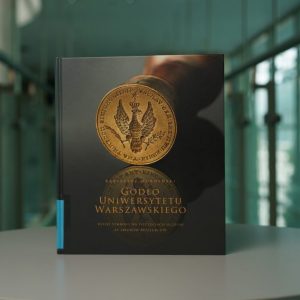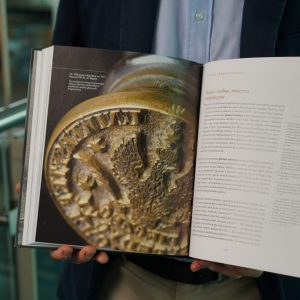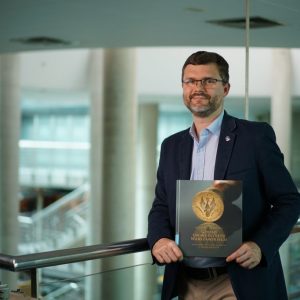“The symbol of the university eagle surrounded by five stars sets the UW apart from other universities in the capital. This emblem has the longest and most beautiful history,” said Dr Krzysztof Mordyński from the UW Museum, presenting his book The Emblem of the University of Warsaw. The History of the Symbol on the Seals from the University Museum in the next episode of the “Read with the UW”.
Dr Krzysztof Mordyński graduated from the Institute of History of the University of Warsaw and completed doctoral studies at the Institute of Art of the Polish Academy of Sciences. His main research interests are the history of urban planning and Warsaw architecture, the history of the University of Warsaw and museology. He also lectures as part of postgraduate (Varsavianistics) and part-time studies at the UW’s Faculty of History.
Dr Mordyński is an author of books, research articles and historical exhibition scripts. His book The Emblem of the University Warsaw was awarded the main prize in the 2024 ACADEMIA competition and other distinguishments: the 2023 Prof. Jerzy Skowronek Award and the 2024 Adam Heymowski Award. He is also a laureate of the KLIO Prize for the book Dreams about Warsaw (PL: Sny o Warszawie).
The projects co-conducted by Dr Mordyński were nominated twice for the Architectural Award of the President of the Capital City of Warsaw (in 2023 and 2024).
In 2019, Dr Mordyński received the award of the Open University UW granted to the best lecturers.
He has been working at the University of Warsaw Museum since 2014.
In the eagle’s talons
“Working on the book took me about three years. I had to visit many archives, libraries, museums and collect a great variety of material. Every source had its relevance. It was not only books, documents, seals and seal matrices, but also various pieces of information scattered in memoires, press releases, and details visible on photographs,” explained Dr Krzysztof Mordyński.
The university emblem of today is the White Eagle surrounded by five stars. It holds a branch of laurel and palm leaves in its talons. The emblem was established in 1817, at a time when the University of Warsaw was organised. These were the beginnings of the University. Later, the Russian occupants prohibited the usage of the emblem and replaced it with an imperial-royal symbol of the Kingdom of Poland. It was a two-headed Russian black eagle, with a shield featuring the White Eagle on its breast. This image reflected Poland’s political situation at the time.
Emblem on the seal
“The university seal with the emblem played a very important role in shaping a new identity of the Kingdom of Poland. The researchers, such as Stanisław Staszic or Stanisław Kostka Potocki, sought to renew the Polish state in a modern form based on the ideas of the Age of Enlightenment,” said Dr Krzysztof Mordyński.
It was Potocki’s design, which was used to create the great seal of the University. The seal certified the completion of master’s and doctoral studies.
“The University of Warsaw was meant to be a place of education in the new spirit for future lawyers, doctors, architects, humanists, physicists or chemists. They would take advantage of the newest science achievements and steer the country in a different direction,” Dr Krzysztof Mordyński emphasised. “A successful completion of studies, an elite master’s degree that guaranteed the candidate’s skills and knowledge, was certified precisely by the university seal,” Dr Mordyński added
Works of art
The oldest seal matrices with the original emblem from 1817 are kept in the University of Warsaw Museum. Originally, there were a dozen of them. However, only a few of the oldest ones and a greater number of matrices from the next decades of the 19th century have lasted until today.
“It is almost a miracle that they have survived all the turbulent history of Poland and our University. They are messengers from the past to the present. Studying them enables us to better capture the ideas, which laid upon the funding of the University,” Dr Mordyński said.
Seal matrices should not be confused with ordinary stamps. As they certified very important documents, they had to be specially manufactured.
“Engravers cut an elaborate drawing of an eagle into the matrix of the seal. In fact, seals are little works of art, which is clearly visible in the zoomed-in photographs presented in the book,” the historian explained.
Located on the Main Gate of the University, the image of the White Eagle surrounded by five stars, which holds in its talons a branch of laurel and palm leaves, welcomes all the people entering the campus at Krakowskie Przedmieście.
The emblem was first placed on the gate in 1916. A metal eagle had different proportions than the one from Potocki’s times. It was slightly slimmer and had its wings raised higher. The emblem was however destroyed right at the beginning of the war in 1939. The eagle returned to Krakowskie Przedmieście in the 1980s.
The book The Emblem of the University of Warsaw. The History of the Symbol on the Seals from the University Museum by Dr Krzysztof Mordyński can be found at the University of Warsaw Library in open access in the “Education” section.
The University of Warsaw Press and the UW Museum received the main prize in the 2024 ACADEMIA competition for the publication The Emblem of the University of Warsaw. The History of the Symbol on the Seals from the University Museum, written by Dr Krzysztof Mordyński. The winner was announced during the Warsaw International Book Fair.







